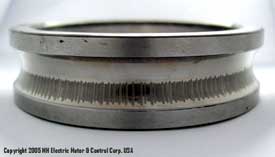paramathma
Aerospace
- Apr 2, 2008
- 47
Hello experts,
We are receiving failed electric motors from field. The motor is connected to a gear pump.
Winding open is observed after checking the connectivity.
Important observations after disassembly of motor
Contact marks on drive end side of rotor and stator see attached figure
Outer ring of Drive end bearing rotating in the housing
Dark color on rotor and stator only on the drive end
With the above information, please help me in identifying the root cause
We are receiving failed electric motors from field. The motor is connected to a gear pump.
Winding open is observed after checking the connectivity.
Important observations after disassembly of motor
Contact marks on drive end side of rotor and stator see attached figure
Outer ring of Drive end bearing rotating in the housing
Dark color on rotor and stator only on the drive end
With the above information, please help me in identifying the root cause

![[2thumbsup] [2thumbsup] [2thumbsup]](/data/assets/smilies/2thumbsup.gif)
